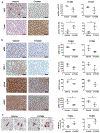A Novel CDK2/9 Inhibitor CYC065 Causes Anaphase Catastrophe and Represses Proliferation, Tumorigenesis, and Metastasis in Aneuploid Cancers
- PMID: 33277443
- PMCID: PMC8011823
- DOI: 10.1158/1535-7163.MCT-19-0987
A Novel CDK2/9 Inhibitor CYC065 Causes Anaphase Catastrophe and Represses Proliferation, Tumorigenesis, and Metastasis in Aneuploid Cancers
Abstract
Cyclin-dependent kinase 2 (CDK2) antagonism inhibits clustering of excessive centrosomes at mitosis, causing multipolar cell division and apoptotic death. This is called anaphase catastrophe. To establish induced anaphase catastrophe as a clinically tractable antineoplastic mechanism, induced anaphase catastrophe was explored in different aneuploid cancers after treatment with CYC065 (Cyclacel), a CDK2/9 inhibitor. Antineoplastic activity was studied in preclinical models. CYC065 treatment augmented anaphase catastrophe in diverse cancers including lymphoma, lung, colon, and pancreatic cancers, despite KRAS oncoprotein expression. Anaphase catastrophe was a broadly active antineoplastic mechanism. Reverse phase protein arrays (RPPAs) revealed that along with known CDK2/9 targets, focal adhesion kinase and Src phosphorylation that regulate metastasis were each repressed by CYC065 treatment. Intriguingly, CYC065 treatment decreased lung cancer metastases in in vivo murine models. CYC065 treatment also significantly reduced the rate of lung cancer growth in syngeneic murine and patient-derived xenograft (PDX) models independent of KRAS oncoprotein expression. Immunohistochemistry analysis of CYC065-treated lung cancer PDX models confirmed repression of proteins highlighted by RPPAs, implicating them as indicators of CYC065 antitumor response. Phospho-histone H3 staining detected anaphase catastrophe in CYC065-treated PDXs. Thus, induced anaphase catastrophe after CYC065 treatment can combat aneuploid cancers despite KRAS oncoprotein expression. These findings should guide future trials of this novel CDK2/9 inhibitor in the cancer clinic.
©2020 American Association for Cancer Research.
Conflict of interest statement
The authors have no conflicts of interest to disclose.
Figures






Similar articles
-
CDK2 inhibition disorders centrosome stoichiometry and alters cellular outcomes in aneuploid cancer cells.Cancer Biol Ther. 2023 Dec 31;24(1):2279241. doi: 10.1080/15384047.2023.2279241. Epub 2023 Nov 30. Cancer Biol Ther. 2023. PMID: 38031910 Free PMC article.
-
Next-Generation CDK2/9 Inhibitors and Anaphase Catastrophe in Lung Cancer.J Natl Cancer Inst. 2017 Jun 1;109(6):djw297. doi: 10.1093/jnci/djw297. J Natl Cancer Inst. 2017. PMID: 28376145 Free PMC article.
-
CDK2 Inhibition Causes Anaphase Catastrophe in Lung Cancer through the Centrosomal Protein CP110.Cancer Res. 2015 May 15;75(10):2029-38. doi: 10.1158/0008-5472.CAN-14-1494. Epub 2015 Mar 25. Cancer Res. 2015. PMID: 25808870 Free PMC article.
-
Engaging Anaphase Catastrophe Mechanisms to Eradicate Aneuploid Cancers.Mol Cancer Ther. 2018 Apr;17(4):724-731. doi: 10.1158/1535-7163.MCT-17-1108. Epub 2018 Mar 20. Mol Cancer Ther. 2018. PMID: 29559545 Free PMC article. Review.
-
Cell death by mitotic catastrophe: a molecular definition.Oncogene. 2004 Apr 12;23(16):2825-37. doi: 10.1038/sj.onc.1207528. Oncogene. 2004. PMID: 15077146 Review.
Cited by
-
Identification of CDK2-Related Immune Forecast Model and ceRNA in Lung Adenocarcinoma, a Pan-Cancer Analysis.Front Cell Dev Biol. 2021 Jul 30;9:682002. doi: 10.3389/fcell.2021.682002. eCollection 2021. Front Cell Dev Biol. 2021. PMID: 34409029 Free PMC article.
-
CDK2 inhibition disorders centrosome stoichiometry and alters cellular outcomes in aneuploid cancer cells.Cancer Biol Ther. 2023 Dec 31;24(1):2279241. doi: 10.1080/15384047.2023.2279241. Epub 2023 Nov 30. Cancer Biol Ther. 2023. PMID: 38031910 Free PMC article.
-
Cyclin-dependent kinase inhibitor fadraciclib (CYC065) depletes anti-apoptotic protein and synergizes with venetoclax in primary chronic lymphocytic leukemia cells.Leukemia. 2022 Jun;36(6):1596-1608. doi: 10.1038/s41375-022-01553-w. Epub 2022 Apr 5. Leukemia. 2022. PMID: 35383271 Free PMC article.
-
Transcriptional CDK inhibitors, CYC065 and THZ1 promote Bim-dependent apoptosis in primary and recurrent GBM through cell cycle arrest and Mcl-1 downregulation.Cell Death Dis. 2021 Aug 3;12(8):763. doi: 10.1038/s41419-021-04050-7. Cell Death Dis. 2021. PMID: 34344865 Free PMC article.
-
Chromosomal Instability-Driven Cancer Progression: Interplay with the Tumour Microenvironment and Therapeutic Strategies.Cells. 2023 Nov 26;12(23):2712. doi: 10.3390/cells12232712. Cells. 2023. PMID: 38067140 Free PMC article. Review.
References
-
- Hanahan D, Weinberg RA. Hallmarks of cancer: the next generation. Cell 2011;144(5):646–74. - PubMed
-
- Nigg EA. Centrosome aberrations: cause or consequence of cancer progression? Nat Rev Cancer 2002;2(11):815–25. - PubMed
-
- Kramer A, Neben K, Ho AD. Centrosome replication, genomic instability and cancer. Leukemia 2002;16(5):767–75. - PubMed
-
- Zyss D, Gergely F. Centrosome function in cancer: guilty or innocent? Trends Cell Biol 2009;19(7):334–46. - PubMed
Publication types
MeSH terms
Substances
Grants and funding
LinkOut - more resources
Full Text Sources
Other Literature Sources
Miscellaneous

